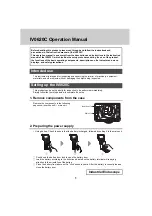
Introduction Series
4060
16
Teledyne
Analytical
Instruments
Extensive self-diagnostic testing at startup and on demand
with continuous power supply monitoring.
RS-232 serial digital port for use with a computer or other
digital communication device.
Analog outputs for concentration and range identification (0-
1 VDC standard and isolated 4-20 mA dc).
Superior Accuracy
1.2 Principle of Operation
The analyzer uses a gas separation column to separate the
component of interest, like benzene, from the other hydrocarbons in the
sample gas. Using a carrier gas and a microprocessor actuated switching
valve, the eluted gas is analyzed in Flame Ionization Detector (FID) and
the column is back flushed to accept the fresh sample in the next cycle.
More information is provided in Section 2.1
Introduction
, under
Operational Theory
. The electrical output of the electrometer-amplifier
is directly proportional to the concentrations of the ionizable
hydrocarbons present over the ranges of interest.
1.3 Analyzer Description
The standard analyzer is a rack mountable instrument designed to fit
into a standard 19” instrument rack. The front interface panel is mounted
on a door which, when opened, allows convenient access to the
Analyzer electronics. The entire front panel can slide out of the chassis
to provide greater access to the electronics and to the sample system.
Gas pressure and flow controls are mounted on the front panel adjacent
to the LED and VFD displays and user interface.
At the rear of the instrument are ports for the introduction of air,
fuel, zero, span, and sample gas. A single 50-pin user-interface cable
connector contains input/output and alarm signals available to the user.
An RS-232 port is also available at the rear panel for connection to a
remote computer or other digital communication device. The Analyzer is
set up for either 120 VAC 60 Hz or 230 50/60 Hz operation depending
on the customer’s requirements. The appropriate power cord for your
unit has been shipped with this instrument.
Figure 1-1 shows the Model 4060 front interface while Figure 1-2
shows the rear panel including the user connections.
















































